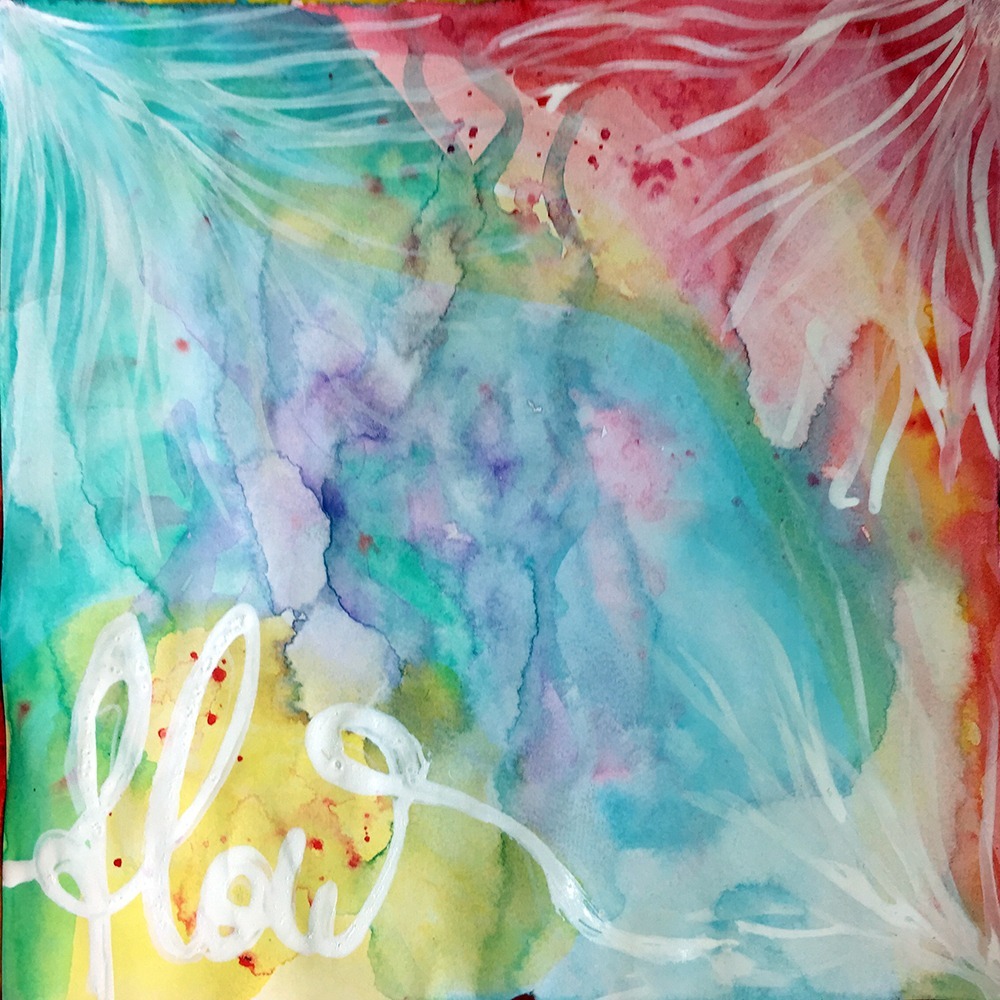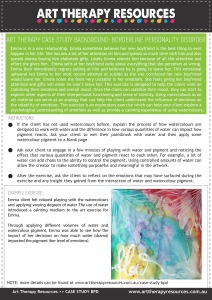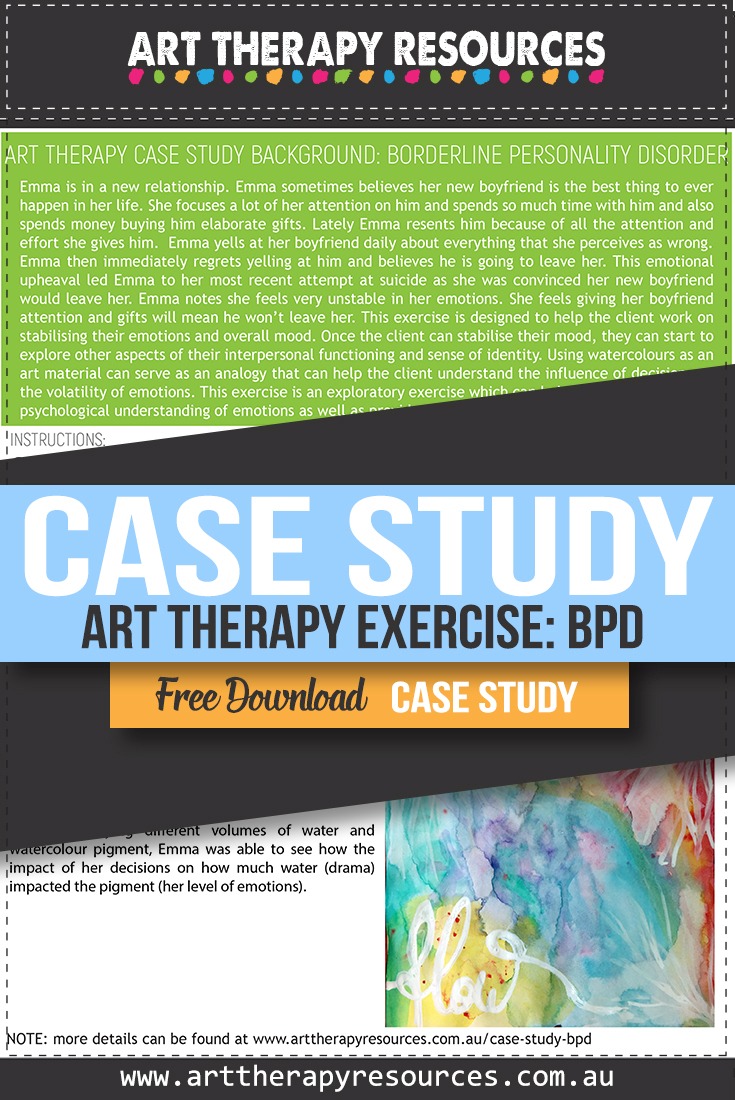THIS POST INCLUDES:
- Art Therapy and BPD
- About the Client
- Current Client Issues
- Art Therapy Exercise
- Client Insight and Outcomes
- Disclaimer
- FREE DOWNLOAD Art Therapy Exercise
ART THERAPY AND BORDERLINE PERSONALITY DISORDER
CHARACTERISTICS OF BPD
Many clients with borderline personality disorder (BPD) experience problems with regulating emotion. Clients with BPD struggle with identity problems and often possess a poor self-image which in turn impacts their interpersonal relationships and response to conflict.
BPD has a strong link to childhood attachment theory which in turn affects adult relationships where BPD clients engage in behavioural patterns that fuels intense relationships which are often short lived and dysfunctional.
Individuals diagnosed with BPD often function within a lack of relationship structure or boundaries. The life of an individual with BPD can often appear chaotic and disorganized.
A number of common traits that are found in individuals with BPD are:
- Anger
- Anxiety
- Concentration difficulties
- Emotion dysregulation
- Impulsivity
- Mood cycles
- Risky behaviours
- Self-injury
- Suicidal thoughts
As the list shows, the life of an individual with BPD can be intense, unpredictable, and impulsive. Unfortunately, due to the impulsive and erratic nature of BPD individuals, negative life outcomes often occur as a consequence of the impulsive behaviour.
In the DSM-IV-TR it is diagnosed with 5 of the following 9 symptoms:
- Frantic efforts to avoid real or imagined abandonment.
- A pattern of unstable and intense interpersonal relationships characterized by alternating between extremes of idealization and devaluation.
- Identity disturbance: Markedly and persistently unstable self-image or sense of self.
- Impulsivity in at least two areas that are potentially self-damaging (e.g., spending, sex, substance abuse, reckless driving, binge eating).
- Recurrent suicidal behavior, gestures, or threats, or self-mutilating behavior
- Affective instability due to a marked reactivity of mood (e.g., intense episodic dysphoria, irritability, or anxiety usually lasting a few hours and only rarely more than a few days)
- Chronic feelings of emptiness
- Inappropriate, intense anger or difficulty controlling anger (e.g., frequent displays of temper, constant anger, recurrent physical fights).
- Transient, stress-related paranoid ideation or severe dissociative symptoms.
HOW ART THERAPY CAN HELP WITH BPD
Art therapy is used regularly for individuals who experience emotional and self-regulation problems. Personality disorders, such as borderline personality disorder, are commonly defined with maladaptive patterns of thought, behaviours, and emotions. These patterns often cause distress and disruption in the individual’s life and their ability to integrate socially.
Art therapy is beneficial to many clients because of its ability to bypass a verbal focus on therapy and instead focus therapeutic attention to emotional experiences and expression.
Individuals with BPD often have contentious interpersonal relationships where they receive negative judgments about their behaviour. Art therapy provides a space that is free of judgment where the client is free to explore and express their thoughts and emotions.
Art therapy removes the need to rely on communication between therapist and client as the primary source for clients to gain insight and understanding into their emotions. Clients are not expected to create and maintain a conversation and can instead focus their therapeutic efforts on exploring uncomfortable emotions. Therapists can help augment the experience of discovery that clients can achieve through creating a art in connection with their experiences. This can provide an encouraging space for change as clients who experience conflict with other relationships about their emotions can still explore their emotional experience without that conflict.
Research by Haeyen, van Hooren, and Hutschemaekers (2015) indicates art therapy can help a client expand on their understanding and insight into circumstances that they view as emotionally threating by:
- Improving perceptions through senses
- Personal formation of identity and self-acceptance
- Improved emotion and impulse regulation
- Behavioural change
- Insight and comprehension into self and into relation to others
Art therapy is beneficial as it directly links to emotional expression and bypasses the need to verbalise and intellectualize emotions through words.
ABOUT THE CLIENT
- Name: Emma
- Age: 27
- Summary of sessions to date: Emma has attended 3 sessions to date. About a month ago she attempted suicide and her psychiatrist suggested some art therapy sessions.
CURRENT CLIENT ISSUES
Emma is currently in a new relationship about 2 months old. Emma sometimes believes her new boyfriend is the best thing to ever happen in her life. She focuses a lot of her attention on him and spends so much time with him and also spends money buying him elaborate gifts.
Lately, Emma resents him because of all the attention and effort she gives him. Emma yells at her boyfriend daily about everything that she perceives as wrong. Emma then immediately regrets yelling at him and believes he is going to leave her. This emotional upheaval led Emma to her most recent attempt at suicide as she was convinced her new boyfriend would leave her.
Emma notes she feels very unstable in her emotions. Emma feels giving her boyfriend attention and gifts will mean he won’t leave her.
ART THERAPY EXERCISE
This exercise is designed to help the client work on stabilising their emotions and overall mood. Once the client can stabilise their mood, they can start to explore other aspects of their interpersonal functioning and sense of identity.
Using watercolours as an art material can serve as an analogy that can help the client understand the influence of decisions on the volatility of emotions.
This exercise is an exploratory exercise which can help your client explore a psychological understanding of emotions as well as provide a calming experience of using watercolours.
INSTRUCTIONS:
- If the client has not used watercolours before, explain the process of how watercolours are designed to work with water and the difference in how various quantities of water can impact how pigment reacts.
- Ask your client to wet their paintbrush with water and then apply some watercolour pigment to a blank page.
- Ask your client to engage in a few minutes of playing with water and pigment and noticing the effect that various quantities of water and pigment react to each other. For example, a lot of water can add chaos to the ability to control the pigment. Using controlled amounts of water can allow the creator to make something purposeful and meaningful in the artwork.
- After the exercise, ask the client to reflect on the emotions that may have surfaced during the exercise and any insight they gained from the interaction of water and watercolour pigment.
SUPPLIES USED INCLUDE:
- Angora Watercolour Pan Set http://amzn.to/2hLxtf1
- Simply Simmons Brushes http://amzn.to/2hramK7
- XL Watercolour Pad (trimmed to 12×12 inch) http://amzn.to/2gGdja2
- Water Bottle
CLIENT INSIGHT AND OUTCOMES
Emma felt relaxed playing with the watercolours and applying varying degrees of water. The use of water introduced a calming medium to the art exercise for Emma.
Through applying different volumes of water and watercolour pigment, Emma was able to see how the impact of her decisions on how much water (drama) impacted the pigment (her level of emotions).

DISCLAIMER
This case study represents a snapshot of the client’s progress in treatment. The exercise in this article could be used as written or as a guide for new and original tasks developed by the Art Therapist. Responsibility for treatment resides with the individual therapist who understands their clients specific needs. The art therapy exercise should not be viewed as a pre-defined directive on how to treat a client that presents with a specific range of problems.This art therapy exercise will help build a database of knowledge to draw upon when helping your client. Art Therapy is associated with psychotherapy techniques, however each therapist often approaches therapy with their own foundation of psychological interventions, whether it be psychotherapy, CBT, DBT or other methods.
FREE DOWNLOAD: Art Therapy Exercise
Download the FREE Art Therapy Exercise based on the above Case Study. The free download includes instructions for the art therapy exercise, along with an example of the art therapy exercise.

BUILD YOUR ART THERAPY REFERENCE MATERIALS:
Pin this image to your Pinterest board.

SHARE KNOWLEDGE & PASS IT ON:
If you’ve enjoyed this post, please share it on Facebook, Twitter, Pinterest. Thank you!
